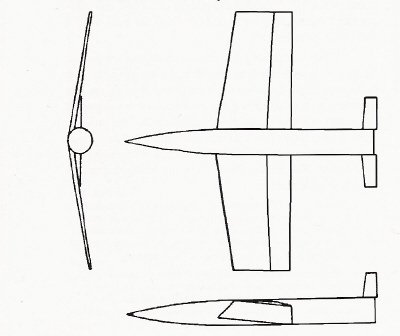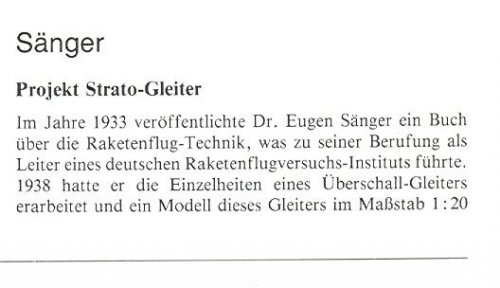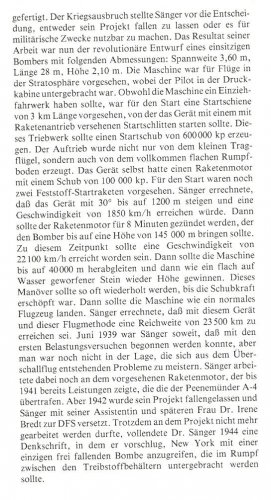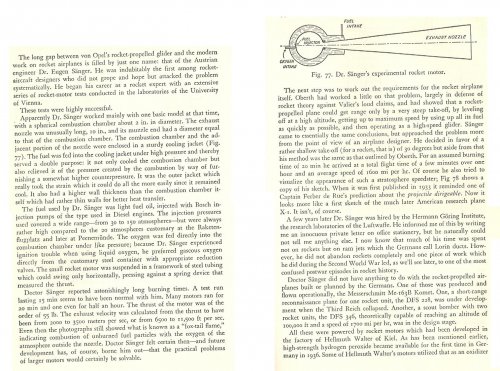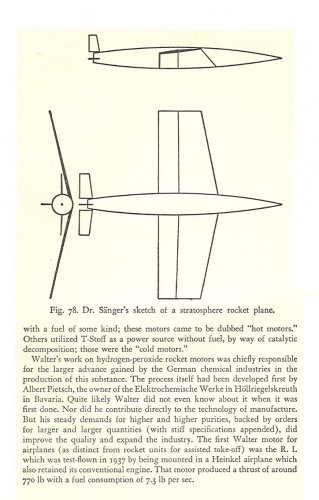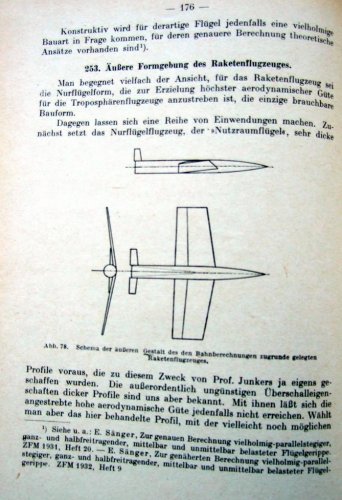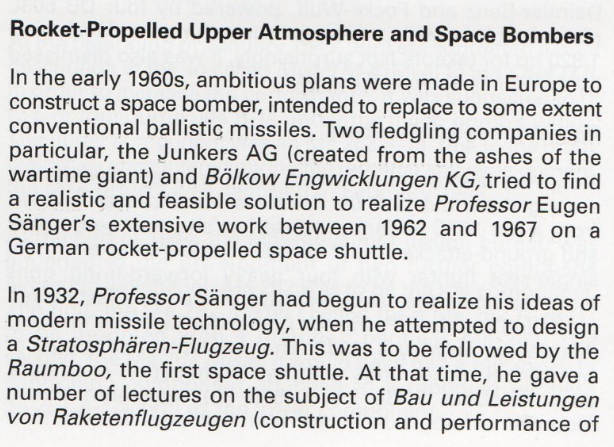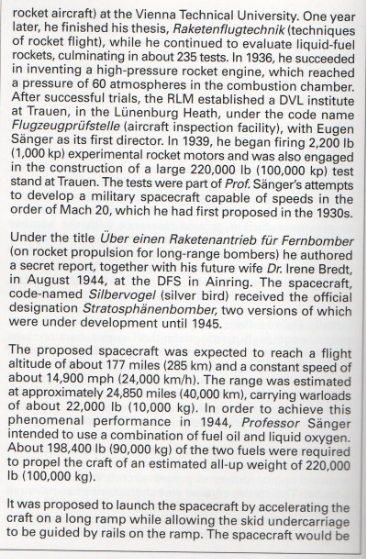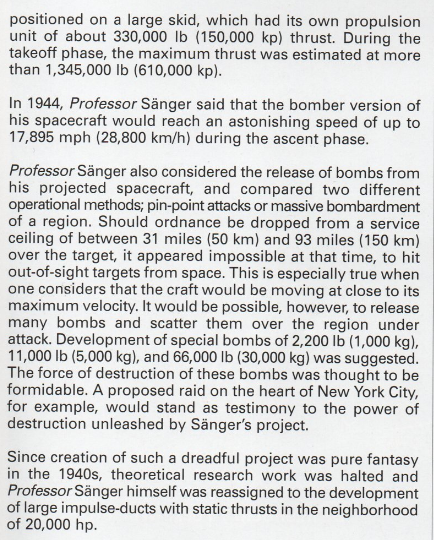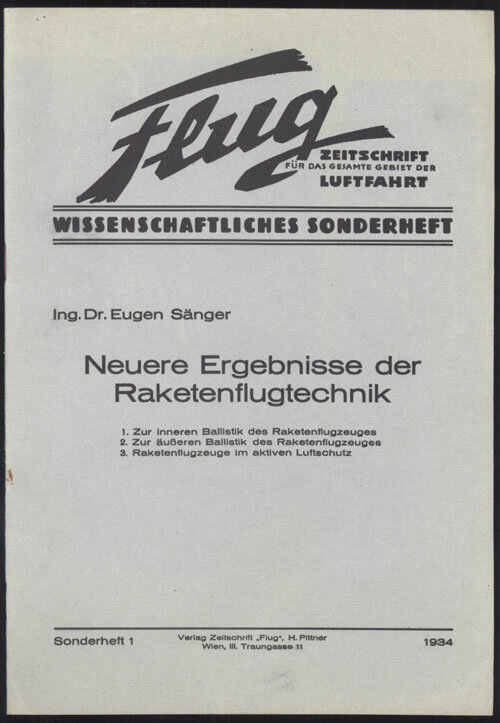You are using an out of date browser. It may not display this or other websites correctly.
You should upgrade or use an alternative browser.
You should upgrade or use an alternative browser.
Eugen Sanger's 1933 rocketplane
- Thread starter Orionblamblam
- Start date
archipeppe
ACCESS: Top Secret
- Joined
- 18 October 2007
- Messages
- 2,435
- Reaction score
- 3,165
Orionblamblam said:Has anybody seen anything *reliable* that gives any sort of dimensions for the rocketplane Sanger designed in '33? Everything I have seems to suggest that it was a "rubber" airplane - i.e. no fixed dimension, to be scaled up or down.
I agree, I've never found out any scale or dimensions with the 3 views.
It seems more like such re-entry shape for study case than a real dimensioned project (unilike the later silbervogel).
OM
ACCESS: Top Secret
..."Rubber" airplane? Sorry, weren't we discussing that on the Inflatable Hypersonic thread?



- Joined
- 13 August 2007
- Messages
- 8,465
- Reaction score
- 11,071
OM said:..."Rubber" airplane? Sorry, weren't we discussing that on the Inflatable Hypersonic thread?



no, only spacecraft who it size is unknown
the 1933 Sänger space plane is describe in his book "Raketenflugtechnik" (Technology of Rocket Flight),
max speed is Mach 10, and part of the coasting and gliding post-boost flight goes up to 60-70 kilometres.
"rubber" airplane model 1:20 scale
Justo Miranda said:"rubber" airplane model 1:20 scale
And without knowing the dimensions of the model...
Besides: what model? I've seen a steel model of his 1944 design, but not of his '33 design.
- Joined
- 13 August 2007
- Messages
- 8,465
- Reaction score
- 11,071
"Die deutsche luftrústung" Band 4 by Heinz J. Nowarra
the German text describe "Silverbird"
i made request at ILR in Aachen
maybe they have book "Raketenflugtechnik"
i wait on answer from them
the German text describe "Silverbird"
i made request at ILR in Aachen
maybe they have book "Raketenflugtechnik"
i wait on answer from them
A complete translation of Sanger's book was published by NASA in the Technical Translation series, I have a copy at home, but that is about a 1000 miles away. It should be in any number of US libraries.
Best Regards,
Artie Bob
Best Regards,
Artie Bob
- Joined
- 12 July 2006
- Messages
- 948
- Reaction score
- 751
Using an illustration from the book "Ein Leben für die Raumfahrt. Erinnerungen an Prof. Dr.-Ing. Eugen A. Sänger", compiled by his son Hartmut E. Sänger (ISBN 3-927697-42-7), I believe this is just a general view how Sänger would have seen a rocket plane around 1933. Another idea, showing a single-seat rocket fighter, is published in the same book, and has very simple dimensions: 10 m length and span.
- Joined
- 13 August 2007
- Messages
- 8,465
- Reaction score
- 11,071
Artie Bob said:A complete translation of Sanger's book was published by NASA in the Technical Translation series,
i try that 2 days ago: Nada, njet, nichts, nothing...
and used search-engine with Sanger, Saenger, Raketenflugtechnik, Technology of Rocket Flight.
but Tomorrow I'm at ILR library and can see the real book ;D
Scott do you need this info for eAPR V2N2 ?
archipeppe
ACCESS: Top Secret
- Joined
- 18 October 2007
- Messages
- 2,435
- Reaction score
- 3,165
What is the "MG Anlage" placed in the front of the rocketplane??
Anlage means "device" in English, but what means the MG?
It seems a sort of primitive thruster system.... ???
Anlage means "device" in English, but what means the MG?
It seems a sort of primitive thruster system.... ???
- Joined
- 12 July 2006
- Messages
- 948
- Reaction score
- 751
archipeppe said:What is the "MG Anlage" placed in the front of the rocketplane??
Anlage means "device" in English, but what means the MG?
Normally "MG" is for "Maschinen-Gewehr" (i. e. 'machine gun') here in Germany. It's a rocket fighter and so it makes sense. But the detail in the drawing is a little bit strange for such a device. So it's pure speculation ??? .
Michel Van said:Scott do you need this info for eAPR V2N2 ?
*Need?* No. *Want?* Yes. This rocketplane is a historical footnote for one of the articles, and I'd like to be complete. But I don't think dimensions for this are ever going to be found, as I suspect Sanger never gave it dimensions.
- Joined
- 13 August 2007
- Messages
- 8,465
- Reaction score
- 11,071
Orionblamblam said:But I don't think dimensions for this are ever going to be found, as I suspect Sanger never gave it dimensions.
Tomorrow we will know more...
- Joined
- 13 August 2007
- Messages
- 8,465
- Reaction score
- 11,071
Orionblamblam said:But I don't think dimensions for this are ever going to be found, as I suspect Sanger never gave it dimensions.
your absolute right Scott !
i wend to ILR and read the book "Raketenflugtechnik".
Sänger never gave its dimensions !
because, it was a "Thought experiment"
the Picture on page 176 show only the ideal form of Spaceplane
back in 1933, based on Wat they know on supersonic then.
Note on the Book "Raketenflugtechnik".
1932 Sänger went to 11 publisher with his manuscript
"Nein, we not print thiz Fantastic rubbish, Get ouT !"
but Sänger dint give up and found publisher who produced Oberth books
however they print only if Sänger pays exorbitant fee to publisher !
it needed Sänger 4 year to work pay the debt off
today you can't pay a original version of "Raketenflugtechnik" anymore
Attachments
Michel Van said:today you can't pay a original version of "Raketenflugtechnik" anymore
About as close to a first edition as I coudl quickly find:
http://www.abebooks.com/servlet/BookDetailsPL?bi=256763960&searchurl=sts%3Dt%26tn%3DRaketenflugtechnik%26x%3D34%26y%3D14
Neuere Ergebnisse der Raketenflugtechnik. In a special issue of Flug.
Sanger, Eugen.
Description: S‰nger, Eugen (1905-64). Neuere Ergebnisse der Raketenflugtechnik. In Flug: Zeitschr. f. d. gesamte Gebiet der Luftfahrt, Sonderheft 1 (1934). 23, [1]pp. Text illustrations. 305 x 211 mm. Original printed wrappers. Fine. First Edition.
Bookseller:
Jeremy Norman's historyofscience.com
(Novato, CA, U.S.A.)
Book Price:
US$ 1250.00
I think that this is just an article, though.
martinbayer
ACCESS: Top Secret
- Joined
- 6 January 2009
- Messages
- 3,402
- Reaction score
- 3,911
An online copy of NASA TT F-223 can be found at https://epizodyspace.ru/bibl/inostr-yazyki/nasa/zenger-rocket_flight_1965.pdf
Temistocle
ACCESS: Secret
- Joined
- 9 December 2009
- Messages
- 247
- Reaction score
- 506
I rembered a description of that plane in the cited Sanger paper from 1934. Here the April 1942 NACA translation, with a sketch at page 49. The dimensions in that page are illegible, but fortunatly in the test thy are reported as 10 x 10 meters, as already stated in previous posts.
Attachments
antigravite
ACCESS: Top Secret
- Joined
- 25 April 2008
- Messages
- 836
- Reaction score
- 258
Michel Van said:today you can't pay a original version of "Raketenflugtechnik" anymore
About as close to a first edition as I coudl quickly find:
Neuere Ergebnisse der Raketenflugtechnik. In a special issue of Flug by Sanger, Eugen: (1934) | Jeremy Norman's historyofscience
1st Edition - Soft cover - Vienna - 1934 - Sanger, Eugen (1905-64). Neuere Ergebnisse der Raketenflugtechnik. In Flug: Zeitschr. f. d. gesamte Gebiet der Luftfahrt, Sonderheft 1 (1934). 23, [1]pp. Text illustrations. 305 x 211 mm. Original printed wrappers. Fine. First Edition. Sanger, a...www.abebooks.com
Neuere Ergebnisse der Raketenflugtechnik. In a special issue of Flug.
Sanger, Eugen.
Description: S‰nger, Eugen (1905-64). Neuere Ergebnisse der Raketenflugtechnik. In Flug: Zeitschr. f. d. gesamte Gebiet der Luftfahrt, Sonderheft 1 (1934). 23, [1]pp. Text illustrations. 305 x 211 mm. Original printed wrappers. Fine. First Edition.
Bookseller:
Jeremy Norman's historyofscience.com
(Novato, CA, U.S.A.)
Book Price:
US$ 1250.00
I think that this is just an article, though.
antigravite
ACCESS: Top Secret
- Joined
- 25 April 2008
- Messages
- 836
- Reaction score
- 258
Hi.
Jeremy Norman happens to be one of the most expensive science book dealers. They belong to the top 10, if it pay say. As of today, there is a *slightly* less expensive copy available from california-based bookseller lwcurrey. L.W. Currey fares expensive prices too; they specialize in science-fiction and the like, and have been around for decades. They usually deal collector books in very good, exceptional or near fine conditions. Bottom line: even though you could find other "reading copies" elsewere, theirs exhibit a general appearance — if not, a degree of rarity — justifying collector's "premium". Their website is fantastic and they have a whole section devoted to the early astronautics, expanding their legacy SciFi activity.
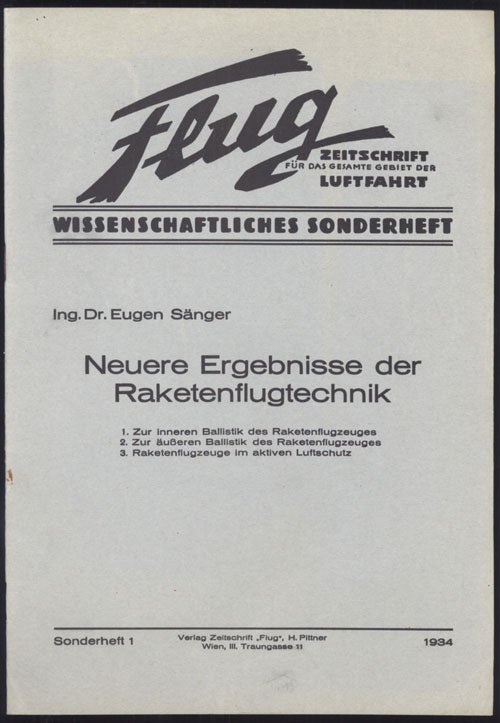
 www.lwcurrey.com
www.lwcurrey.com
A.
PS) I am not affiliated in any way to lwcurrey but strongly encourage you to visit their website anyway
Jeremy Norman happens to be one of the most expensive science book dealers. They belong to the top 10, if it pay say. As of today, there is a *slightly* less expensive copy available from california-based bookseller lwcurrey. L.W. Currey fares expensive prices too; they specialize in science-fiction and the like, and have been around for decades. They usually deal collector books in very good, exceptional or near fine conditions. Bottom line: even though you could find other "reading copies" elsewere, theirs exhibit a general appearance — if not, a degree of rarity — justifying collector's "premium". Their website is fantastic and they have a whole section devoted to the early astronautics, expanding their legacy SciFi activity.

NEUERE ERGEBNISSE DER RAKETENFLUGTECHNIK by Eugen Sänger on L. W. Currey, Inc
Wien: Verlag Zeitschrift Flug, H. Pittner, 1934. Large octavo, pp. 1 2-22 23: ads 24: blank , 25 illustrations, diagrams and charts in the text, original gray wrappers printed in black, stapled. First edition. A famous paper which describes Sanger's experiments on a motor to power a high...
A.
PS) I am not affiliated in any way to lwcurrey but strongly encourage you to visit their website anyway
Attachments
Last edited:
antigravite
ACCESS: Top Secret
- Joined
- 25 April 2008
- Messages
- 836
- Reaction score
- 258
As an addendum, a historical note of interest. Hartmut Sänger (Eugen Sänger's son, who was a very good friend), informed me in 2008 that all of his father's archives had been copied by (photographed?) — but not donated to, as far as I can remember — the MIT to enter their Library for future researchers. The actual archival material was later transferred from Stuttgart (Eugen's house) to the Berlin Technical Museum. Eugen Sänger's Stuttgart house had a special room to store sensitive documents. It was like a bunker and could only be accessed by a very thick bank-like safe door.
A.
A.
Last edited:
Pierre TIAN
ACCESS: Restricted
- Joined
- 11 December 2020
- Messages
- 8
- Reaction score
- 2
Pierre TIAN replied.
Eugen Sanger Silberbird was a very beutifull and genial project, that already in 1940 prevised an aft up lift surface, later in 1950 studied at Short plant. It was never built because a too heavy budget of creation and maintenance. But from 1941, the cryogenic oxygen hydrogen rocket was tested at Trauen/ Fassberg. The testbench was destroyed by the Britishes in 1944. Ruins ans housing and sheds were partly used in the sixties for the Deutsche Raketen Zentrum, centered Stuttgart Institute.
The Sanger Silberbird memorandum was printed in 50 folds, which roneo nr 1 that of Sanger himself, is still to be consulted at Musee de l Air et de l Espace, Le Bourget at Paris
Valves and the miracle multistage pump were the only parts that were build. The pump throned for years on Sanger desk at Polygone de Chatillon in Montrouge, South of Paris. I suppose that later was in possession of Irene Sanger / Bredt, ihis wife, and today belong to Hartmuth, their son
Eugen Sanger Silberbird was a very beutifull and genial project, that already in 1940 prevised an aft up lift surface, later in 1950 studied at Short plant. It was never built because a too heavy budget of creation and maintenance. But from 1941, the cryogenic oxygen hydrogen rocket was tested at Trauen/ Fassberg. The testbench was destroyed by the Britishes in 1944. Ruins ans housing and sheds were partly used in the sixties for the Deutsche Raketen Zentrum, centered Stuttgart Institute.
The Sanger Silberbird memorandum was printed in 50 folds, which roneo nr 1 that of Sanger himself, is still to be consulted at Musee de l Air et de l Espace, Le Bourget at Paris
Valves and the miracle multistage pump were the only parts that were build. The pump throned for years on Sanger desk at Polygone de Chatillon in Montrouge, South of Paris. I suppose that later was in possession of Irene Sanger / Bredt, ihis wife, and today belong to Hartmuth, their son
antigravite
ACCESS: Top Secret
- Joined
- 25 April 2008
- Messages
- 836
- Reaction score
- 258
Pierre TIAN replied.
Eugen Sanger Silberbird was a very beutifull and genial project, that already in 1940 prevised an aft up lift surface, later in 1950 studied at Short plant. It was never built because a too heavy budget of creation and maintenance. But from 1941, the cryogenic oxygen hydrogen rocket was tested at Trauen/ Fassberg. The testbench was destroyed by the Britishes in 1944. Ruins ans housing and sheds were partly used in the sixties for the Deutsche Raketen Zentrum, centered Stuttgart Institute.
The Sanger Silberbird memorandum was printed in 50 folds, which roneo nr 1 that of Sanger himself, is still to be consulted at Musee de l Air et de l Espace, Le Bourget at Paris
Valves and the miracle multistage pump were the only parts that were build. The pump throned for years on Sanger desk at Polygone de Chatillon in Montrouge, South of Paris. I suppose that later was in possession of Irene Sanger / Bredt, ihis wife, and today belong to Hartmuth, their son
Dear Pierre,
Thank you. There are a few corrections to be added.
Eugen Sänger's report "UM 3538" was printed in 100 copies only, not 50. Many of them were destroyed. 3 of them were obtained by the Soviet Union, reaching Stalin who prompted his son to kidnap Sänger in France. Tokaty blew this off and Sänger was protected. I have even obtained a numbered, restricted diffusion Russian translation of the UM3538 report. The original report in German was translated into French by Alexandre Ananoff who befriended with Sänger's at war's end, as Sänger stayed and worked in France. Ananoff organized what is known today as the International Astronautical Congres and Sänger later became the president of the International Astronautical Federation. Ananoff's archives were transfered to Le Bourget Museum.
A.
antigravite
ACCESS: Top Secret
- Joined
- 25 April 2008
- Messages
- 836
- Reaction score
- 258
Pierre TIAN replied.
Eugen Sanger Silberbird was a very beutifull and genial project, that already in 1940 prevised an aft up lift surface, later in 1950 studied at Short plant. It was never built because a too heavy budget of creation and maintenance. But from 1941, the cryogenic oxygen hydrogen rocket was tested at Trauen/ Fassberg. The testbench was destroyed by the Britishes in 1944. Ruins ans housing and sheds were partly used in the sixties for the Deutsche Raketen Zentrum, centered Stuttgart Institute.
The Sanger Silberbird memorandum was printed in 50 folds, which roneo nr 1 that of Sanger himself, is still to be consulted at Musee de l Air et de l Espace, Le Bourget at Paris
Valves and the miracle multistage pump were the only parts that were build. The pump throned for years on Sanger desk at Polygone de Chatillon in Montrouge, South of Paris. I suppose that later was in possession of Irene Sanger / Bredt, ihis wife, and today belong to Hartmuth, their son
Dear Pierre,
Thank you. There are a few corrections to be added.
Eugen Sänger's report "UM 3538" was printed in 100 copies only, not 50. Many of them were destroyed. 3 of them were obtained by the Soviet Union, reaching Stalin who prompted his son to kidnap Sänger in France. Tokaty blew this off and Sänger was protected. I have even obtained a numbered, restricted diffusion Russian translation of the UM3538 report. The original report in German was translated into French by Alexandre Ananoff who befriended with Sänger's at war's end, as Sänger stayed and worked in France. Ananoff organized what is known today as the International Astronautical Congres and Sänger later became the president of the International Astronautical Federation. Ananoff's archives were transfered to Le Bourget Museum.
A.
FWIW, Hartmut Sänger died a few years ago, while repairing his Mini sports car, not the one that Ferdinand Porsche offered him. All of the archives are now at the Berlin Technical Museum, including, I believe the historical rocket engine you mention.
A

